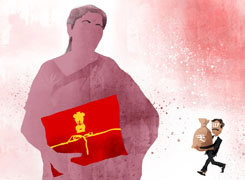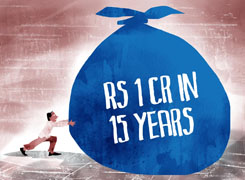Ramalingam Kalirajan |10874 Answers |Ask -Follow
Mutual Funds, Financial Planning Expert - Answered on Jul 14, 2024
He has an MBA in finance from the University of Madras and is a certified financial planner.
He is the director and chief financial planner at Holistic Investment, a Chennai-based firm that offers financial planning and wealth management advice.... more

I am 29 years old and I am a senior product analyst. I have started investing in SIP in 3 funds at the start of this financial year. 1. Axis small cap with 5k 2. Mahindra manulife midcap with 5k 3. Navi nifty 50 index with 5k I started this mutual fund for for second daughter as a disciple saving as I already have sukanya scheme for elder daughter. Please suggest if I can diversify more in any other sip funds. Am I ok with the portfolio? Needs to add more money?
Current Portfolio Overview
Your current investment strategy includes the following SIPs:
Axis Small Cap: Rs 5,000 monthly.
Mahindra Manulife Midcap: Rs 5,000 monthly.
Navi Nifty 50 Index: Rs 5,000 monthly.
These investments are geared towards your second daughter, while you already have the Sukanya Samriddhi Yojana (SSY) for your elder daughter. This demonstrates a prudent approach to securing your children's financial futures.
Portfolio Analysis
Your portfolio comprises small cap, midcap, and index funds. Each fund type offers different benefits and risks. Let’s evaluate each:
Small Cap Fund
Small cap funds can provide high returns over the long term. However, they are also highly volatile. Your investment in Axis Small Cap indicates a willingness to accept higher risk for potentially higher returns. Given your age, this is reasonable, but diversification can help manage the associated risks.
Midcap Fund
Midcap funds strike a balance between the high risk of small caps and the stability of large caps. Mahindra Manulife Midcap Fund is a good choice to achieve moderate growth. Midcaps tend to perform well over longer investment horizons, which aligns with your goal for your daughters' future.
Index Fund
Navi Nifty 50 Index Fund offers a diversified investment in the top 50 companies in India. While index funds have lower expense ratios, they do not outperform the market as actively managed funds might. As a Certified Financial Planner, I would suggest considering actively managed funds for higher potential returns.
Suggested Improvements and Diversification
Actively Managed Funds
Actively managed funds have the potential to outperform index funds. Fund managers actively select stocks and adjust the portfolio based on market conditions. This can result in better returns, especially in volatile markets. Consider adding actively managed large-cap or multi-cap funds to your portfolio for potential superior performance.
Debt Funds
To balance the risk, adding some debt funds can provide stability. Debt funds invest in fixed income securities, which can protect your capital and provide steady returns. This will also help in reducing overall portfolio volatility.
Diversified Equity Funds
Diversified equity funds invest across market capitalizations. They provide exposure to various sectors and can mitigate risks associated with investing in a single market segment. Including a diversified equity fund in your portfolio can enhance risk-adjusted returns.
International Funds
Investing in international funds can provide exposure to global markets. This diversification can reduce reliance on the Indian market alone and take advantage of growth in other economies. International funds can be a good hedge against domestic market volatility.
Increasing Investment Amount
Considering the long-term nature of your goal and the power of compounding, increasing your SIP amount can significantly boost your investment corpus. Even a small increment in your monthly investment can lead to substantial growth over time. Evaluate your financial capacity and consider increasing your SIPs to accelerate wealth creation.
Monitoring and Reviewing Portfolio
Regularly monitoring your portfolio and reviewing its performance is crucial. This ensures that your investments remain aligned with your goals and risk tolerance. Make adjustments as needed based on market conditions and personal circumstances.
You are doing a commendable job by planning for your daughters' futures at such an early stage. Your disciplined approach to savings and investments is admirable. Balancing between high-risk, high-reward investments and stable, low-risk options shows your dedication to financial planning.
Benefits of Investing through a Certified Financial Planner
Investing through a Certified Financial Planner (CFP) provides several advantages. CFPs offer professional advice tailored to your financial goals. They help in selecting the right funds, ensuring optimal asset allocation, and adjusting the portfolio based on market dynamics. This can significantly enhance your investment outcomes.
Avoiding Direct Funds
Direct funds might seem appealing due to lower expense ratios. However, investing through a Mutual Fund Distributor (MFD) with CFP credentials can offer valuable insights and support. Regular funds come with expert management and guidance, which can be crucial in navigating complex market scenarios.
Benefits of Regular Funds
Regular funds provide access to professional management. Fund managers actively track market trends and make informed decisions to maximize returns. The additional cost of regular funds is justified by the potential for better performance and comprehensive financial advice.
Final Insights
Your current portfolio demonstrates a solid foundation for long-term growth. By diversifying further and considering actively managed funds, debt funds, and international exposure, you can enhance your portfolio's performance and stability. Increasing your SIP amount and seeking guidance from a Certified Financial Planner will further optimize your investment strategy.
Your commitment to securing your daughters' futures is commendable. With a balanced and diversified approach, you are well on your way to achieving your financial goals. Remember to review your portfolio regularly and make adjustments as needed to stay on track.
Best Regards,
K. Ramalingam, MBA, CFP,
Chief Financial Planner,
www.holisticinvestment.in
Best Regards,
K. Ramalingam, MBA, CFP,
Chief Financial Planner,
www.holisticinvestment.in
You may like to see similar questions and answers below
Ramalingam Kalirajan |10874 Answers |Ask -Follow
Mutual Funds, Financial Planning Expert - Answered on May 17, 2024
Ramalingam Kalirajan |10874 Answers |Ask -Follow
Mutual Funds, Financial Planning Expert - Answered on Jun 16, 2024
Ramalingam Kalirajan |10874 Answers |Ask -Follow
Mutual Funds, Financial Planning Expert - Answered on Oct 22, 2025
Anu Krishna |1746 Answers |Ask -Follow
Relationships Expert, Mind Coach - Answered on Dec 08, 2025
Ramalingam Kalirajan |10874 Answers |Ask -Follow
Mutual Funds, Financial Planning Expert - Answered on Dec 08, 2025
Samraat Jadhav |2499 Answers |Ask -Follow
Stock Market Expert - Answered on Dec 08, 2025
Ramalingam Kalirajan |10874 Answers |Ask -Follow
Mutual Funds, Financial Planning Expert - Answered on Dec 08, 2025
Radheshyam Zanwar |6737 Answers |Ask -Follow
MHT-CET, IIT-JEE, NEET-UG Expert - Answered on Dec 08, 2025
Nayagam P P |10852 Answers |Ask -Follow
Career Counsellor - Answered on Dec 07, 2025

Research Career Prospects: IISc, IITs, and Beyond: For research-oriented careers, the Integrated M.Sc Physics program at Amrita provides an exceptional foundation. Amrita's curriculum specifically aligns with GATE and UGC-NET examination syllabi, and the institution emphasizes early research engagement. The faculty at Amrita actively publish research in Scopus-indexed journals, with over 60 publications in international venues within the past five years, exposing you to active research environments.
To pursue research at premier institutions like IISc, you would typically follow the PhD pathway. IISc accepts M.Sc graduates through their Integrated PhD programs, and with your Amrita M.Sc, you're eligible to apply. You'll need to qualify the relevant entrance examinations, and your integrated program's emphasis on research fundamentals provides strong preparation. The final year of your Integrated M.Sc is intentionally structured to be nearly free of classroom commitments, enabling engagement with research projects at institutes like IISc, IITs, and National Labs. According to Amrita's data, over 80% of M.Sc Physics students secured internship offers from reputed institutions during academic year 2019-20, directly facilitating research career transitions.
Placement and Direct Employment Opportunities: Amrita University boasts a comprehensive placement ecosystem with strong corporate and government sector connections. According to NIRF placement data for the Amrita Integrated M.Sc program (5-year), the median salary in 2023-24 stood at ?7.2 LPA with approximately 57% placement rate. However, these figures reflect general placement trends; physics graduates often secure higher packages in specialized technical roles. Many graduates join software companies like Infosys (with early offers), Google, and PayPal, where their strong analytical and computational skills command competitive compensation packages ranging from ?8-15 LPA for entry-level positions.
The Department of Corporate and Industrial Relations at Amrita provides intensive three-semester life skills training covering linguistic competence, data interpretation, group discussions, and interview techniques. This structured placement support significantly enhances your employability in both government and private sectors.
Government Sector Opportunities: UPSC, BARC, DRDO, and ISRO: Your M.Sc Physics degree opens multiple avenues for prestigious government employment. UPSC Geophysicist examinations explicitly list M.Sc Physics or Applied Physics as qualifying degrees, enabling you to compete for Group A positions in the Geological Survey of India and Central Ground Water Board. The age limit for geophysicist positions is 32 years (with relaxation for reserved categories), and the exam comprises preliminary, main, and interview stages.
BARC (Bhabha Atomic Research Centre) actively recruits M.Sc Physics graduates as Scientific Officers and Research Fellows. Recruitment occurs through the BARC Online Test or GATE scores, with positions in nuclear science, radiation protection, and atomic research. BARC Summer Internship programs are available, offering ?5,000-?10,000 monthly stipends with opportunity for future scientist recruitment.
DRDO (Defense Research and Development Organization) recruits M.Sc Physics graduates through CEPTAM examinations or GATE scores for roles involving defense technology, weapon systems, and laser physics research. ISRO (Indian Space Research Organisation) regularly advertises scientist/engineer positions through competitive recruitment for candidates with strong physics backgrounds, offering opportunities in satellite technology and space science applications.
Other significant employers include the Indian Meteorological Department (IMD) recruiting as scientific officers, and NPCIL (Nuclear Power Corporation of India Limited), offering stable government service with competitive compensation packages exceeding ?8-12 LPA for scientists.
Alternate Career Pathways: UPSC, CDS, and AFCAT: UPSC Civil Services (IFS - Indian Forest Service): M.Sc Physics graduates qualify for UPSC Civil Services examinations, with the forest service offering opportunities for science-based administrative roles with potential to reach senior government positions.
CDS/AFCAT (Armed Forces): While AFCAT meteorology branches specifically require "B.Sc with Maths & Physics with 60% minimum marks," the technical branches (Aeronautical Engineering and Ground Duty Technical roles) require graduation/integrated postgraduation in Engineering/Technology. An M.Sc Physics integrates well with technical qualifications, though you would need engineering background for direct officer entry. However, you remain eligible for specialized technical interviews if applying through alternate defence channels.
UGC-NET Examination: This pathway leads to Assistant Professor positions in central universities and colleges across India. NET-qualified candidates receive scholarships of ?31,000/month for 2-year JRF positions with PhD pursuit, transitioning to Assistant Professor salaries of ?41,000/month in government institutions. This route provides long-term academic career security with research opportunities.
Private Sector Technical Roles
M.Sc Physics graduates are increasingly valued in data science, software engineering, and technical consulting. Companies actively recruit physics graduates for software development, where strong problem-solving and logical reasoning translate to competitive packages of ?10-20 LPA. Specialized domains including quantum computing development, financial modeling, and scientific computing offer premium compensation. Your minor in Scientific Computing makes you particularly attractive to technology companies requiring computational expertise.
International Opportunities and Higher Studies Abroad
An M.Sc from Amrita facilitates admission to PhD programs at international institutions. German universities offer tuition-free or low-fee MSc Physics programs (2 years) with scholarships like DAAD providing €850+ monthly stipends. US universities accept M.Sc graduates directly for PhD positions with full funding (tuition coverage + stipend). These pathways require GRE scores and strong Statement of Purpose articulating research interests. Research collaboration opportunities exist with Max Planck Institute (Germany) and CalTech Summer Research Program (USA), both welcoming Indian M.Sc students.
Essential Skills and Certifications to Develop Immediately: Programming Languages: Start learning Python immediately—it's universally used in research and industry. Dedicate 2-3 hours weekly to data analysis, scientific computing libraries (NumPy, SciPy, Pandas), and machine learning fundamentals. MATLAB is equally critical for physics applications, particularly numerical simulations and data visualization. Aim to complete MATLAB certification courses within your first year.
Research Tools: Learn Git/version control, LaTeX for scientific documentation, and data analysis frameworks. These skills are indispensable for publishing research papers and collaborating on projects.
Certifications Worth Pursuing: (1) MATLAB Certification (DIYguru or MathWorks official courses) (2) Python for Data Science (complete certificate programs from platforms like Coursera) (3) Machine Learning Fundamentals (for expanding technical versatility) & (4) Scientific Communication and Technical Writing (develop through departmental workshops)
Strategic Internship Planning: Leverage Amrita's research connections systematically. In your third year, apply to BARC Summer Internship, IISER Internships, TIFR Summer Fellowships, and IIT Internship programs (like IIT Kanpur SURGE). These expose you to frontier research while establishing connections for future PhD or scientist recruitment. Target 2-3 research internships across different specializations to develop versatility.
TO SUM UP, Your Integrated M.Sc Physics degree from Amrita positions you exceptionally well for competitive research careers at IISc/IITs, prestigious government scientist roles at BARC/DRDO/ISRO, and international PhD opportunities. The program's scientific computing emphasis differentiates you in the job market. Immediate priorities: (1) Master Python and MATLAB within the first two years; (2) Engage in research projects starting year 2-3; (3) Target internships at premiere research institutions; (4) Prepare GATE while completing your degree for maximum flexibility in recruitment; (5) Consider UGC-NET for long-term academic stability. Your career trajectory will ultimately depend on developing strong research fundamentals, demonstrating consistent excellence in specialization areas, and strategically selecting internship and research opportunities. The rigorous Amrita program combined with disciplined skill development positions you for exceptional career success across multiple sectors. Choose the most suitable option for you out of the various options available mentioned above. All the BEST for Your Prosperous Future!
Follow RediffGURUS to Know More on 'Careers | Money | Health | Relationships'.
Nayagam P P |10852 Answers |Ask -Follow
Career Counsellor - Answered on Dec 07, 2025
Radheshyam Zanwar |6737 Answers |Ask -Follow
MHT-CET, IIT-JEE, NEET-UG Expert - Answered on Dec 06, 2025

Good luck.
Follow me if you receive this reply.
Radheshyam
Dr Nagarajan J S K |2576 Answers |Ask -Follow
NEET, Medical, Pharmacy Careers - Answered on Dec 06, 2025
Mihir Tanna |1090 Answers |Ask -Follow
Tax Expert - Answered on Dec 06, 2025























